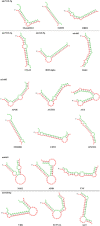Genetic and epigenetic factors of arterial hypertension: a bibliometric- and in-silico-based analyses
- PMID: 37900914
- PMCID: PMC10602687
- DOI: 10.3389/fmolb.2023.1221337
Genetic and epigenetic factors of arterial hypertension: a bibliometric- and in-silico-based analyses
Abstract
Introduction: Arterial hypertension (AH) is a pervasive global health concern with multifaceted origins encompassing both genetic and environmental components. Previous research has firmly established the association between AH and diverse genetic factors. Consequently, scientists have conducted extensive genetic investigations in recent years to unravel the intricate pathophysiology of AH. Methods: In this study, we conducted a comprehensive bibliometric analysis employing VOSviewer software to identify the most noteworthy genetic factors that have been the focal point of numerous investigations within the AH field in recent years. Our analysis revealed genes and microRNAs intricately linked to AH, underscoring their pivotal roles in this condition. Additionally, we performed molecular docking analyses to ascertain microRNAs with the highest binding affinity to these identified genes. Furthermore, we constructed a network to elucidate the in-silico-based functional interactions between the identified microRNAs and genes, shedding light on their potential roles in AH pathogenesis. Results: Notably, this pioneering in silico examination of genetic factors associated with AH promises novel insights into our understanding of this complex condition. Our findings prominently highlight miR-7110-5p, miR-7110-3p, miR-663, miR-328-3p, and miR-140-5p as microRNAs exhibiting a remarkable affinity for target genes. These microRNAs hold promise as valuable diagnostic and therapeutic factors, offering new avenues for the diagnosis and treatment of AH in the foreseeable future. Conclusion: In summary, this research underscores the critical importance of genetic factors in AH and, through in silico analyses, identifies specific microRNAs with significant potential for further investigation and clinical applications in AH management.
Keywords: arterial hypertension; epigenetic factors; genetic factors; in silico analyses; miRNA.
Copyright © 2023 Karabaeva, Vochshenkova, Zare, Jafari, Baneshi, Mussin, Albayev, Kaliyev, Baspakova and Tamadon.
Conflict of interest statement
Authors AZ, NJ, HB, and AT were employed by the company PerciaVista R&D Co. The remaining authors declare that the research was conducted in the absence of any commercial or financial relationships that could be construed as a potential conflict of interest.
Figures






References
-
- Abramova M. Y., Usacheva T. A., Sorokina I. N., Verzilina I. N., Polyakova I. S., Kulikovsky V. F. (2020). Insilico test of functional role of rs8068318 polymorphism of arterial hypertension-associated TBX2 candidate gene. Sys Rev. Pharm. 11 (6), 07–10. 10.31838/srp.2020.6.02 - DOI
-
- Alyabyeva P. V., Petrova M. M., Dmitrenko D. V., Garganeeva N. P., Chumakova G. A., Al-Zamil M., et al. (2023). Association of single-nucleotide polymorphisms Rs2779249 (chr17: 26128581 C> A) and Rs rs2297518 (chr17: chr17: 27769571 G> A) of the NOS2 gene with tension-type headache and arterial hypertension overlap syndrome in Eastern Siberia. Genes 14 (2), 513. 10.3390/genes14020513 - DOI - PMC - PubMed
-
- Babicheva A., Jain P., Zhao T., Xiong M., Lai N., Makino A., et al. (2020). Decreased microRNA‐153 promotes endothelial-to-mesenchymal transition in idiopathic pulmonary arterial hypertension. FASEB J. 34 (S1), 1. 10.1096/fasebj.2020.34.s1.07429 - DOI
-
- Baptista R., Marques C., Catarino S., Enguita F. J., Costa M. C., Matafome P., et al. (2018). MicroRNA-424 (322) as a new marker of disease progression in pulmonary arterial hypertension and its role in right ventricular hypertrophy by targeting SMURF1. Cardiovasc Res. 114 (1), 53–64. 10.1093/cvr/cvx187 - DOI - PubMed
Publication types
LinkOut - more resources
Full Text Sources

